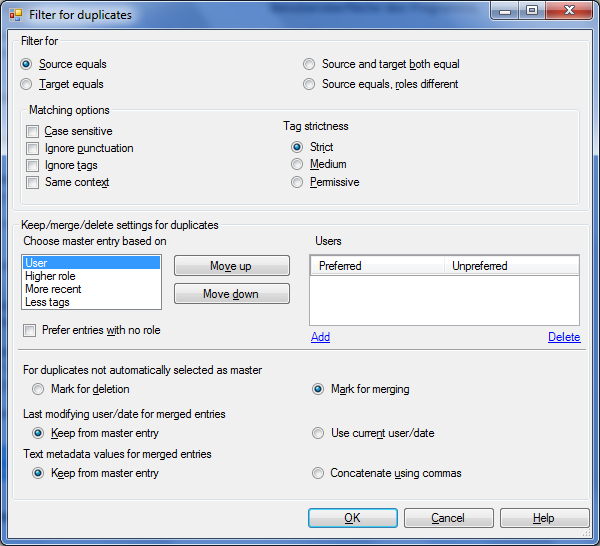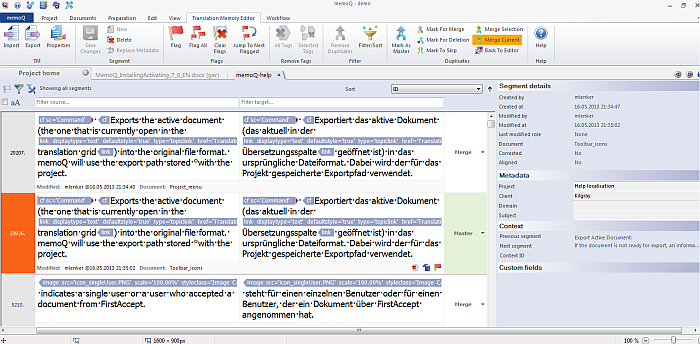|
Maybe your TM contains entries where the source is equal, you want to delete these entries, but also merge entries, having a master entry, or set an entry as preferred/not preferred because some translators are better than others or by role (reviewed entries by a reviewer role are preferred over translated ones). With the TM duplicate filter, you can filter for various types of duplicates: same source + target, same source, same target. How to beginIn Project home, navigate to the Translation memories pane (click the Translation memories icon on the left). Select a translation memory that you are using in your project, and then click the Edit button on the Translation Memories ribbon tab. Or go to the Resource console > Translation Memories. Select a translation memory, and click the Edit link. Click OK in the following filter dialog to leave the defaults, or set TM filter settings. The translation memory editor appears. Click the Remove Duplicates button on the Translation Memory Editor ribbon tab. The Filter for duplicates dialog appears:
After you made your choices, click OK. The TM editor is now filtered based on the duplicate removal options you selected:
Each row is marked as master or for merge. Click the arrow icon next to either Merge or Master for further options (Master, Merge, Delete, Skip). If you, for example, change an entry marked as Master to Merge, then there is no more Master entry for merge. This duplicate will be skipped from the merge operation. You are not allowed to select several TM entries in the already duplicate removal view of the TM editor. You can merge one selected row, or you merge all entries marked as duplicate in your TM and having a master entry indicated to merge the duplicate entries into it. OptionsIn the Filter for section, choose: •Source equals radio button to search all entries with the same source •Target equals radio button to search all entries with the same target (same translation) •Source and target both equal radio button to search all entries where source and target are equal •Source equals, roles different radio button to search all entries where the source is equal, but entries were stores with different user roles (Translator, Reviewer 1, Reviewer 2, None) In the Matching options section, choose the matching options for entries: •Case sensitive: Check this check box to filter for all duplicates which match the case sensitivity. •Ignore punctuation: Check this check box to ignore punctuation in the duplicate search. •Ignore tags: Check this check box to ignore tags in the duplicate search. •Same context: Check this check box to check for context in the duplicate search. •Tag strictness: Choose Strict, Medium or Permissive radio button. By default, Strict is selected. See also: Edit TM Settings. To learn more about how tag strictness works, see this topic: Tag strictness and match rates In the Keep/merge/delete settings for duplicates section, choose the master entry based on: •User: Choose a master entry based on a user. •Higher role: Choose a master entry based on a role, for example the Reviewer 2 role is ranked highest. •More recent: The date/time is used, Last modified date if present, Creation date, if not present. •Less tags: Choose a master entry with less tags in it. Check the Prefer entries with no role check box to search for TM entries with no role stored with it. Preferred entries with no role means that an entry with no role is preferred against an entry with any role, when the entries are compared on the basis or roles. None > R2 > R1 > T if checked, while R2 > R1 > T > None if unchecked. Use the Move up and Move down buttons to move the priority of a search criteria up or down. If you move up the More recent settings, then the duplicate search will first search for the most recently stored duplicates in the TM. You can also add users as preferred or unpreferred users. In the Users section, click the Add link. The Add preferred/unpreferred user dialog appears:
Enter a user name in the User name field. It can also be a prefix. Choose the Preferred or Unpreferred radio button for this user. If you entered a user name prefix in the User name field, then check the This is a user name prefix check box. Click OK to add a user as either preferred or unpreferred user. You can also delete a user from the Users list in selecting the user and clicking the Delete link. You can also do a single entry merging In the For duplicates not automatically selected as master section, choose what to do with duplicates that are not selected as the master entry in the TM: •Mark for deletion: all duplicate entries found in the duplicate search are automatically marked to be deleted. •Mark for merging: all duplicate entries found in the duplicate search are automatically marked to be merged with the master entry. In the Last modifying user/date for merged entries section, choose what to do with duplicates that were last modified in the TM: •Keep from master entry: Choose this radio button to not store the last modified entry in the master TM entry. •Use current user/date: Choose this radio button to merge entries using the current user or date. When you merge an entry, you can keep the master entry or the last modified entry (by a user and date). In the Text metadata values for merged entries section, choose to •Keep from master entry: Choose this radio button to not store metadata from merged entries in the master TM entry. •Concatenate using commas: Choose this radio button to merge entries and to separate metadata by comma. NavigationClick OK to close the Filter for duplicates dialog and to filter your TM now according to your Duplicate filtering settings. The TM editor mode turns into the TM in merge mode. Click the Duplicate button again to leave the duplicate removal mode and to go back to the normal TM editing mode. If there are uncommitted changes, a dialog appears where you need to confirm to leave the duplicate removal/merging entries mode. If you choose No, all changes are discarded. |


